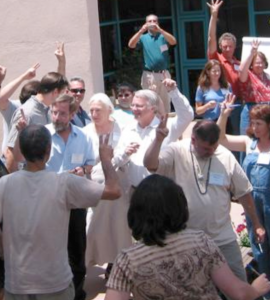
Original author
Resource type
Content area
Use type
Tools
Tags
Here's a list of activities categorized by type:
-
Live-action participatory simulation plus an associated StarLogo model
-
Computer based activities to introduce programming concepts:
-
Computer based activities to introduce complex systems concepts:
-
Live-action participatory simulations to demonstrate complex systems and/or computer science concepts
-
Table top activities to reinforce Math concepts (graphing, coordinates)
Activities using a participatory simulation and an StarLogo model: These activities allow students to participate in a simulation and so explore concepts behind the lesson, and then to view an agent-based model of the same activity, and discuss general principles of modeling.
Tryangles. This activity is a variation of Swords & Shields, where students are introduced to patterns arising from individual agents following simple rules, with some elements of randomness and distal causality. The model of Tryangles is a StarLogo TNG model, which can be viewed using any computer with TNG installed. See TryAngles SLTNG model (appended below)
Rock Paper Scissors activity Most students know the game of rock paper scissors (Ro-sham-bo) and this activity plays the game in a more structured way, to introduce concepts of random movement, collisions, breeds, and traits. The StarLogo Nova model, Rock Paper Scissors, can be easily built by students with basic knowledge of the program.
Majority Rules (Red or Green) This simulation asks students to silently select one of two options (in New Mexico, between Red and Green Chile, although any choice works), and then to move around randomly and whisper their choice to other players, and to change their selection in order to remain in the majority (or stay in the minority). It introduces coding concepts of collisions and traits, and is applicable in studying social dynamics. The StarLogo Nova Opinion dynamics model demonstrates one way to code this activity.
Human Boolean search activity One of several activities to introduce students to the concepts of Boolean Logic, it also introduces the coding concepts of conditionals and traits. See “George Boole says” model
Battle of the agents A take on the board game Battleship, using pencil and paper, to introduce how StarLogo Nova uses x and y coordinates to locate agents.
Battle of the Agents in StarLogo Nova (base model)
Computer based activities to introduce computer science concepts:
Intro to Modeling Change: The first lesson of the Modeling Change unit introduces students to StarLogo Nova. Students create a model which changes an agent's location (using keyboard controls).
Spirograph. If possible, use the classic art toy, then create StarLogo Nova computer models to simulate the same end result by using looping to create a pattern.
Lightbot An activity in the Code.org Hour of Code program, which introduces various coding concepts. Allow students to have fun with the first two or three levels of the program, and then challenge them to recreate the same activity from scratch using StarLogo Nova. One of many ways to mimic Lightbot
Loopy A web-based “tool to make interactive simulations” which introduces many computer science concepts.
Computer based activities to introduce complex adaptive systems concepts:
Fishbanks is an online activity demonstrating shared use of limited resources.
Parable of the Polygons - A computer-based activity for use with the segregation model, where students can explore how a small preference or a historic segregation can lead to total segregation.
Participatory simulations which demonstrate complex systems concepts and/or computer science concepts
27 blind mice Students use different strategies to understand the difference between global and local communication.
Tit for Tat Activity and Tit for Tat worksheet The basic “prisoner’s dilemma” game theory activity, introducing strategies of individual versus group benefits. “Golden Balls” video (to accompany Tit for Tat) Illustrates one strategy for playing a single, high-stakes round of this game.
My robotic friends - A cup-stacking activity to teach use of specific instructions and algorithms.
PB&J robot An activity demonstrating the importance of precise, step-by-step instructions when writing code.
Getting loopy: A participatory simulation to demonstrate use of loops in programming.
Toss Up paper-and-pencil activity on probability and spread of disease spread, examining variables of virulence, duration, and transmission rate.
Math activities (graphing, coordinates)
"What are the chances?" A pencil and paper activity to explore randomness and how to program percent chance in StarLogo Nova.
Code.org dice race Introduction to using algorithms

